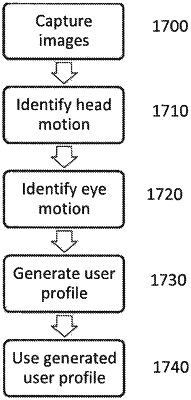| CPC G06F 3/013 (2013.01) [G06F 3/012 (2013.01); G06F 3/0482 (2013.01); G06F 3/04842 (2013.01)] | 14 Claims |

|
1. A method for modifying interactive content in dependence upon a user profile, the method comprising:
obtaining the user profile comprising information about an eye-in-head radius, the eye-in-head radius representing an amount of a display viewable by a user by moving their eyes only, and without moving their head;
identifying interactive elements in displayed content;
identifying a respective selection area associated with each of the identified interactive elements; and
modifying interactions between the user and one or more of the identified interactive elements in dependence upon the obtained user profile, wherein the modifying includes:
locating one or more of the identified interactive elements in dependence on the eye-in-head radius, and
selecting a given one of the identified interactive elements by evaluating selection criteria, which includes determining one of the respective selection areas associated with the given one of the identified interactive elements, and determining whether an overlap threshold between the eye-in-head radius and the one of the respective selection areas has been reached as to the given one of the identified interactive elements, and if so performing an interaction with the given one of the identified interactive elements, and wherein:
the eye-in-head radius represents a maximal area of the display that is larger than, and circumscribes, a given focus area at which the user gazes on the display, where the maximal area of the display includes only the amount of the display viewable by the user by moving their eyes only, and without moving their head,
each of the respective selection areas includes a respective predefined area that is larger than, and circumscribes, the respective identified interactive element, and
the selecting the given one of the identified interactive elements is based on determining whether the respective selection area associated with the given one of the identified interactive elements at least partially overlaps the eye-in-head radius when the user is gazing at a given focus area.
|